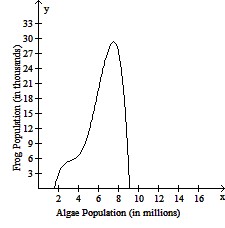Determine the quadrant in which the point is located.(-5, 3)
A. Quadrant I
B. Quadrant II
C. Quadrant III
D. Quadrant IV
Answer: B
You might also like to view...
Provide an appropriate response.Which is the common denominator for  ,
,  , and
, and  ?
?
A. 72 B. 100 C. 2 D. 36
Find the least common multiple of the pair of polynomials. 36y6, 44y3
A. 396y3 B. 396y6 C. 1584y3 D. 1584y6
Completely factor the polynomial or state that the polynomial is prime.(x + 10)2 - 16
A. (x + 14)(x + 6) B. (x - 6)(x - 14) C. (x + 26)(x - 6) D. x2 + 20x + 84
Solve the problem.Given an algae population in a certain pond, x (in millions), f(x) models the frog population in the pond (in thousands). (i) Use the graph of f to estimate the number of algae in the pond when there are 29 thousand frogs in the pond; (ii) Estimate f(x) at 2, 3, 5, 6 and 7; (iii) Use regression and the points you estimated to find a quartic polynomial function f that models the data points; (iv) Use f(x) to solve part (i) either graphically or numerically. 
A. (i) about 1 million
(ii)  (approximately; answers may vary);
(approximately; answers may vary);
(iii) f(x) ? -0.18x4 + 3.27x3 + 20.02x2 + 55.93x - 46.00;
(iv) x ? 1.1 million algae when f(x) = 29 thousand frogs
B. (i) about 1 million
(ii) 
(iii) f(x) ? 0.16x4 + 3.77x3 + 20.02x2 + 51.93x - 44.00;
(iv) x ? 1.5 million algae when f(x) = 29 thousand frogs
C. (i) about 5 million
(ii)  (approximately; answers may vary);
(approximately; answers may vary);
(iii) f(x) ? -0.18x4 + 3.77x3 - 20.02x2 + 41.93x - 44.00;
(iv) x ? 5.1 million algae when f(x) = 29 thousand frogs
D. (i) about 7 million
(ii)  (approximately; answers may vary);
(approximately; answers may vary);
(iii) f(x) ? -0.18x4 + 3.27x3 - 20.02x2 + 51.93x - 44.00;
(iv) x ? 7.3 million algae when f(x) = 29 thousand frogs